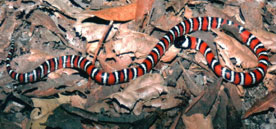See below HTML representation of USFS Document.
You may click any photo to see a larger view. Note: Some full size photos differ from thumbnails.
San Bernardino National Forest Animals
The San Bernardino National Forest is home to a number of rare plants and animals. Our biologists are always trying to learn more about these unique species and we would like to enlist your help as our eyes and ears. If you should ever encounter any of the species described below, please notify us with information about what you saw, when you saw it, and where you saw it. All of these animals are protected species—so please do not handle them, collect them, or harm them in any way. Photographs would be greatly appreciated.
Arroyo toad: This rare toad looks a lot like its more common cousin, the western toad. These amphibians are able to survive dry spells by burrowing into the ground and aestivating for months at a time. Aestivating is similar to hibernating but it’s done during hot dry periods instead of during the winter. These toads are between about 2 – 5 inches in size.
Southern rubber boa: This small docile snake looks like a giant earthworm. It is active at dawn and dusk, especially during rainy periods. This small snake ranges between one foot to one-and-a-half feet long.
San Bernardino Mountain kingsnake: This colorful snake has declined in numbers due to over-collecting by people who want to keep them as pets. These snakes are between 20 – 40 inches long.
San Bernardino ringneck snake: This two-toned snake flashes its orange belly when intimidated or scared, trying to scare off predators. These snakes are between 10 –16 inches long.
San Diego coast horned lizard: Like the San Bernardino Mountain kingsnake, coast horned lizards have been over-collected. These cute little “dinosaurs” generally freeze when scared because their camouflaged patterns make them blend into the background. These lizards are about 2 – 4 inches long.
San Bernardino flying squirrel: This mammal is a subspecies of the northern flying squirrel and it is only known to occur in the San Bernardino and San Jacinto Mountains. They don’t actually fly—instead, they glide on thick pieces of skin spread between their legs. These animals like to den in cavities at the top of dead trees. Flying squirrels are much smaller than the common gray squirrel; they’re closer in size to our local chipmunks.
Large-blotched salamander: This is one of the only salamanders that occurs in the San Bernardino Mountains. They are nocturnal and most active during wet periods. These salamanders are about 2 -3 inches long.
Mountain yellow-legged frog: This frog was once our most common frog; now it is very rare. Part of its decline is probably due to bullfrogs and trout that have been introduced to our mountain streams—they eat these frogs and their tadpoles. These frogs are about 2 –3 inches long.
For more information, please contact Marc Stamer (office: 909.382.2828; cellphone: 909.844.6683; mstamer@fs.fed.us) or Robin Eliason (909.382.2832; cellphone: 909.844.4131; reliason@fs.fed.us). Big Bear Ranger Station, P.O. Box 290, Fawnskin, CA 92333
Photographs obtained from: http://elib.cs.berkeley.edu/photos/. Flying squirrel – Dr. Lloyd Ingles; southern rubber boa –Jens V. Vindum; arroyo toad, mountain kingsnake, ringneck snake, and coast-horned lizard – William Flaxington; mountain yellow-legged frog – Pierre Fidenci; large-blotched salamander – Chuck Brown.
Notes by Sequoia (No affiliation to United States Forest Service):
While most of these animals are not protected by threatened or endangered species laws they are still animals of interest. Please be absolutely positive that you have correctly identified the animal in question, preferably with photographs, before calling in to log the site. Not only is this to make sure the USFS has accurate information on the location and numbers of species of interest it will also minimize chances of road or area closures based on false information.
Thank you,
G. Sequoia Armstrong
You may download a printable version of the above document here.









